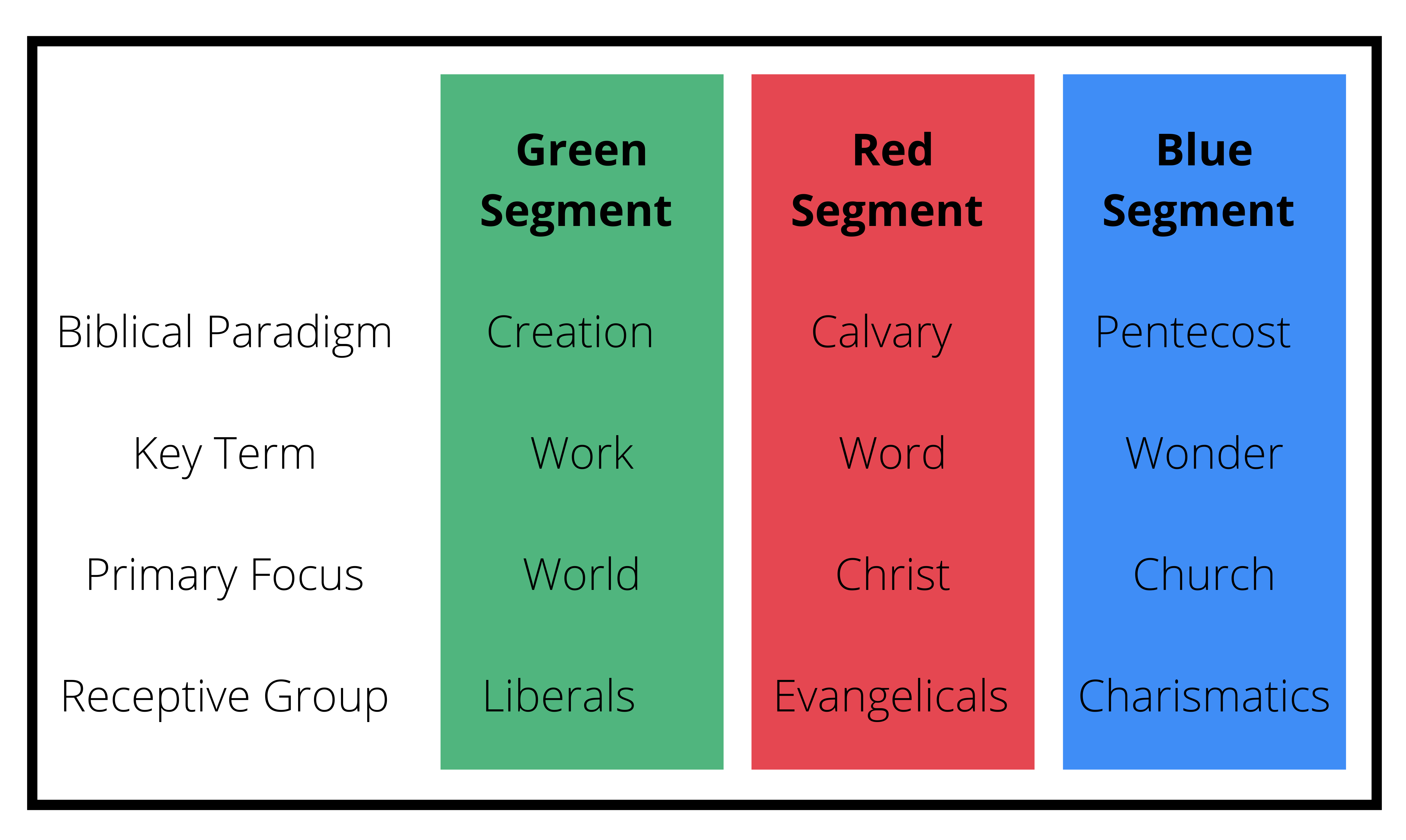How to Develop a Three-Color Church
After completing an inventory of your spiritual gifts, you hopefully have a better idea of what spiritual gifts you possess. However, knowing your area(s) of giftedness is only the first step; this knowledge is not an end in and of itself. Instead, this understanding reveals the task(s) to which you have been called and the way(s) in which God expects you to be involved. And, as always, your gifts should be used to the betterment of the church and to the glory of God.
The Three-Color Church
Churches are divided into three different categories (i.e., color segments). The table below shows different tendencies churches have in regard to spiritual gifts. Since God wants His church to reflect His fullness, He endows the church with gifts in all three areas. However, not all churches utilize all three colors.

If your church is primarily green, is this divinely ordained? Or is it because “birds of a feather flock together?” It might be a bit of both. Christian A. Schwarz (2001) writes in The 3 Colors of Ministry, “It is quite natural for those gifts that are taught, expected, and encouraged in a given church to be discovered more readily than those gifts that are not part of the church’s culture” (p. 53). This means that churches may foster specific gifts, while at the same time bringing in new faces that align with those same gifts.
Just as our understanding of God is skewed when we do not perceive Him in all three colors, our churches are meant to blend the three colors in their reflection of Him to receive blessing of a full revelation of God. “It’s not God’s plan that individual believers reflect His fullness all by themselves” (Schwarz, 2001, p. 88). The church needs to work together to reflect God’s fullness. Just as we should pursue balance of the three colors in our own personal lives, the optimal goal for our churches is to be balanced in the three colors, as well.
Determining Your Church’s Color Blend
Do you know the color blend of your church? This doesn’t mean you know the “ideal” or that you see your church’s “potential.” Instead, it means you have an accurate picture of the colors your church truly reflects. One way to determine where your church–as a whole–stands is to have the entire church participate in the Gift eTest and collect the results for the whole church. This will give you a good picture of the church’s predominant color/areas of strength.
Another helpful resource might be a corporate analysis of the Change Compass (found on pages 34–37 of The 3 Colors of Ministry) or the NCD Color Profile (found on pages 72–76 of Color Your World with Natural Church Development). This information can also be generated with the Advanced Profile option on our website. Other forms of analysis include evaluation your church’s core values, its devotional style, worship style, and so on.
How Can My Church Become More Balanced?
Have you ever thought about other churches or denominations like this?
– “If reflecting more of the color blue means becoming more like this or that charismatic church, we definitely aren’t interested. Sorry, but I’m not into all that ‘signs and wonders’ stuff.”
– “We’ve had enough experiences with evangelical churches that stress the color red to know that this is not the right thing for us. Can you believe they believe that you are saved by grace alone?”
– “You can only speak that naively about the green segment because you have never encountered the disastrous consequences of liberal theology; do you know what happens when there aren’t rules?”
It’s easy to spot the faults of other churches or ministries, specifically when we give them labels such as “liberal,” “evangelical,” or “charismatic.” However, when we evaluate our own church, it can be much harder to make generalized fault statements.
But you may be asking, “How can my church become more balanced in our reflection of all three colors?” The great part of determining our church’s color blend is that once we know where we are, we can more easily determine where we need to go. That is, once we figure out our color blend, we can focus on growing areas in which we are weaker.
Barriers to Growth
Unfortunately, there are barriers to growth. One of the main ones is exposure to other Christian groups that poorly reflect the ideals that God exemplifies. Many times, rather than looking at God and asking, “How can we better reflect a complete picture of Him in our churches?” we look to other human entities and see how imperfectly they are reflecting Him.
The labels of “evangelical,” “charismatic,” and “liberal” only serve to hold us back further from coming into alignment with reflecting God. Instead of looking to these human groups, we should, instead, “fix our eyes on Jesus” (Heb. 12:2), focusing on His nature rather than the way other churches reflect Him.
What do you do if your church is missing certain gifts from one of the color areas? As we’ve said before, it’s not uncommon for churches to foster a specific culture, thereby bringing in more people with the same gifts and strengths. While it is impossible for church/ministry leaders to produce spiritual gifts (only God can do that!), it is vital to create a climate in which certain gifts can grow. In this way, the eight quality characteristics (in accordance with its corresponding color) can be encouraged and fostered.
As you consider your church or ministry, what color do you think is your strongest? In what area do you need to grow the most? What barriers are preventing you from taking steps toward more completely reflecting God? Please share your thoughts in the comment section below; we’d love to hear from you!
Reference
Schwarz, C. A. (2001). The 3 colors of ministry. St. Charles, IL: ChurchSmart Resources.
Share this:
- Click to print (Opens in new window)
- Click to email a link to a friend (Opens in new window)
- Click to share on Reddit (Opens in new window)
- Click to share on Tumblr (Opens in new window)
- Click to share on Pocket (Opens in new window)
- Click to share on Pinterest (Opens in new window)
- Click to share on LinkedIn (Opens in new window)


